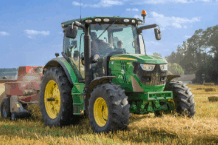The thing that very nearly led to the extinction of an entire species, the American Bison, was what they call, “The Tragedy of the Commons.” In other words, the 19th century Americans saw the bison as owned by everybody, but owned by no one.
And the parallels between how we saw the bison then and how we see the Ogallala Aquifer now are striking — and ominous. If you turn back the clock to the years of 1871 to 1874, the western Kansas bison herd was virtually annihilated in that four-year period by hunters anxious to satisfy the lucrative hide market back east.
This was a classic example of “The Tragedy of the Commons” — individuals consuming a resource at the expense of society. By the 1900s, only 500 bison were left out of the 20 million head that used to graze in the Great Plains.
The “Tragedy” concept was made popular by American ecologist Garrett Hardin. In explaining the idea, he used the example of ranchers grazing their cattle on a common field. When the field is not over capacity, ranchers may graze their animals with few limitations. But the rational rancher will want to add livestock to increase profits. By thinking logically, not collectively, the rancher benefits. But the costs are shared.
The tragedy is that ultimately no rancher will be able to use the field due to overgrazing. Kansas State University researchers led by irrigation engineer Jonathan Aguilar, Garden City Experiment Station, says in trying to better understand perceptions regarding Ogallala use, they surveyed 8,000 producers in Kansas, Colorado, Nebraska, New Mexico, Texas and Oklahoma — states overlying the Ogallala. And guess what? They found very interesting — and troubling — attitudes.
Aguilar points out that producers view groundwater as important for their own farms and their communities. “Producers also clearly believe that groundwater should be conserved for use by future generations,” he says.
So far, so good. But beyond that lies a serious conflict in attitude. Aguilar says even though they see the importance of groundwater, producers do not have a strong sense, at all, of their personal responsibility for the depletion of this resource. Neither do they feel the need for them to reduce groundwater use. In fact, they believe they should not, or cannot, reduce their use of irrigation water.
But can an individual accomplish something on his own? Wallace County farmer Bill Mai tried that. Their family decided a number of years ago to shut off some of their irrigation wells largely in an attempt to save water for future generations. Fortunately, one of the wells they shut off just happened to be a state-monitored observation well.
And low and behold, even though the Mai family no longer pumped the well, the water level continued to drop precipitously due to active neighboring wells to the northwest and to the southeast — and these were wells that were over a mile away.
Former K-State ag economist Don Pretzer agrees this is exactly what will happen with individual efforts at water conservation. He explained that if four irrigators each own a quarter of land in a square section and if one wants to conserve his water for later use, all he’s going to get for his efforts is a warm feeling in his heart that he conserved — and his neighbors will get all his water. Looks like we’re building a case for community action … and regulation.
A great example of moving in the right direction is the LEMA (Local Enhanced Management Area) recently established by Groundwater Management District No. 1 based in Scott City. In that district, all irrigators will voluntarily cut back on water use somewhere between 5% and 25% based on their historic consumption.
One of the problems we have with the Ogallala here in Kansas is that there are a number of groundwater management districts. And beyond that, this aquifer underlies a number of states — each speaking a different language and each with a different philosophy about how to utilize this shared resource.
In looking back a number of years ago here in Kansas, when faced with the corporate hog issue, our legislature took the easy way out and punted the issue down to the county level. But on issues like hogs, there should have been a statewide policy on how to manage this resource.
One of the problems with other or multiple units of government trying to manage resources that cross boundary lines is that certain districts, for instance, may see themselves as competing and wish to maximize their resource at the expense of their neighbor. Or along the same lines, they may see common authority as a threat to their sovereignty. These are tough issues.



